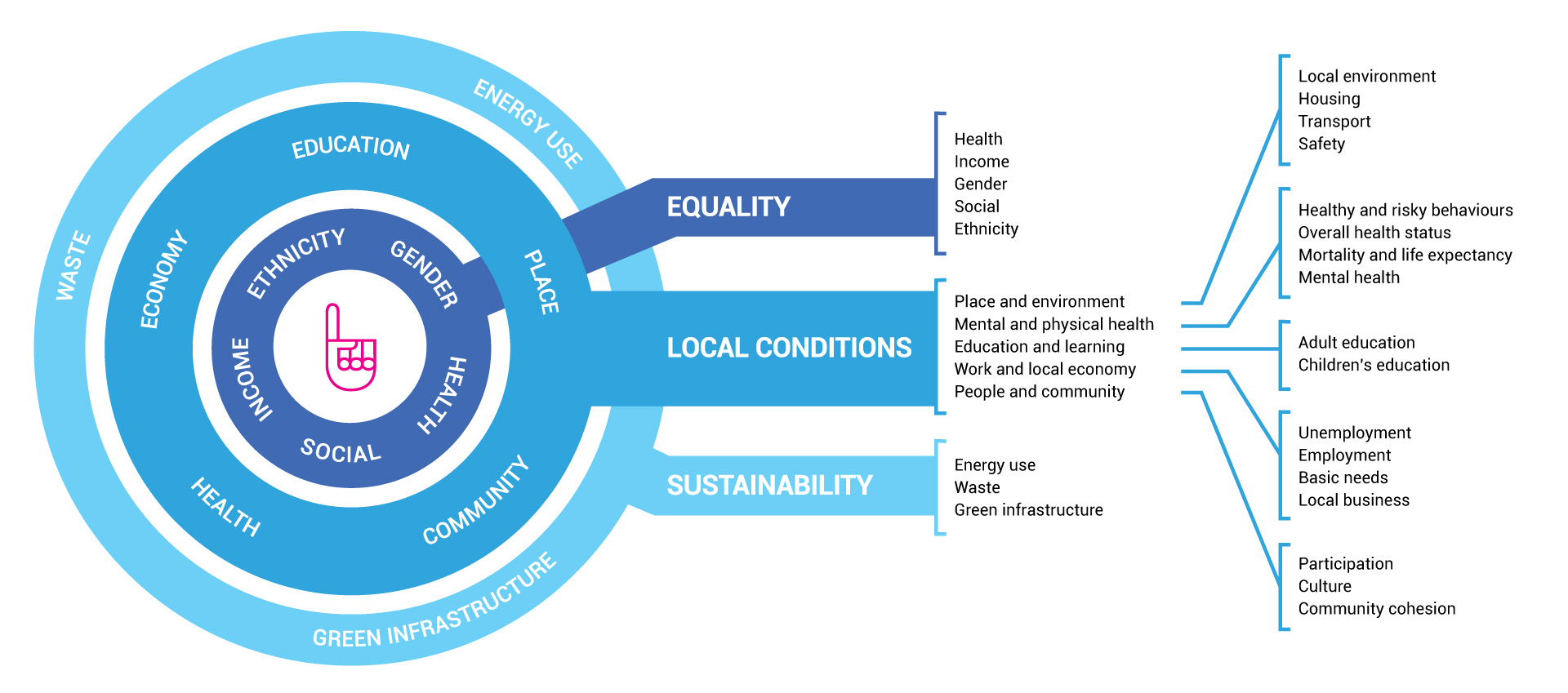About the Thriving Places Index
The TPI framework identifies the local conditions for wellbeing and measures whether those conditions are being delivered fairly and sustainably.
The TPI is arranged into three headline elements designed to provide a clear narrative and a set of shared goals:
 Local Conditions
Local Conditions
 Equality
Equality
 Sustainability
Sustainability
And below those headlines, there are a number of policy and action domains as well as more detailed set of priority target intervention areas (through subdomains)

Behind all of this sit a broad range of indicators to reflect the diversity of action and actors in systemic place-based change. These indicators are selected from datasets produced by established data agencies such as the Office for National Statistics (ONS), Public Health England (PHE) and the Index of Multiple Deprivation (IMD). We select indicators that measure or provide a proxy for, the key factors known to have an influence on wellbeing. The TPI includes data for all upper and lower tier Local Authorities in England and Wales.
Summary scores
The scores for each headline element (out of 10) are shown in each Local Authority’s summary score.
Scorecards
Within each headline element there are domains and subdomains which show the headline elements broken down into greater detail.
Each Local Authority area has a scorecard which shows the colour-coded scores for headline elements, domains and subdomains.
Read more about the methodology and assumptions behind the TPI here.
How is the Thriving Places Index different from other data sets?
It’s consistent
The indicators that are chosen for the TPI measure evidence-based drivers of wellbeing – they are robust, valid and representative and available at Local Authority level. Measuring the same drivers for wellbeing for all Local Authorities in England and Wales provides a level of consistency that makes it possible to compare different places as well as draw connections between regional and national themes.
It’s comprehensive
The TPI offers its users a framework that brings together key data across the whole system of a place. It takes complex ideas and makes them accessible to citizens and practical for project teams on the ground. This makes it possible to understand interconnected issues through a single framework.
It’s challenging
The asset-based approach behind the TPI points to what drives wellbeing, not just what limits it. It shows how sustainably and fairly the conditions for wellbeing are being delivered, shining a crucial light on inequality and intergenerational justice and challenging the current growth-at-all-costs paradigm.
It’s practical
Local data supports local action and the indicators are chosen based on how amenable they are to Local Authority implementation. The TPI provides a shared perspective to inform and evaluate multi-stakeholder projects and programmes, and to drive better wellbeing policy and practice.
Use the Thriving Places Index as a strategic framework for change
The Thriving Places Index (TPI) is a flexible tool which can and is being used by communities, organisations and local government and public sector bodies around he UK and beyond.
The TPI framework offers a new way to think about and change policy emphasis, providing a more interconnected model of local prosperity with wellbeing and fairness at its core. It’s a practical sense-making tool for shaping local policy, budgeting, commissioning, procurement, and decision making at every level to deliver a more equitable and sustainable future.
To find out more about the many ways the TPI can be used and adapted go to the ‘Using the TPI’ pages here
Find out more about how Centre for Thriving Places can work with you to create bespoke Thriving Places Index data sets and offer consultancy to embed new ways of working in your organisation. Read more here or contact us here

